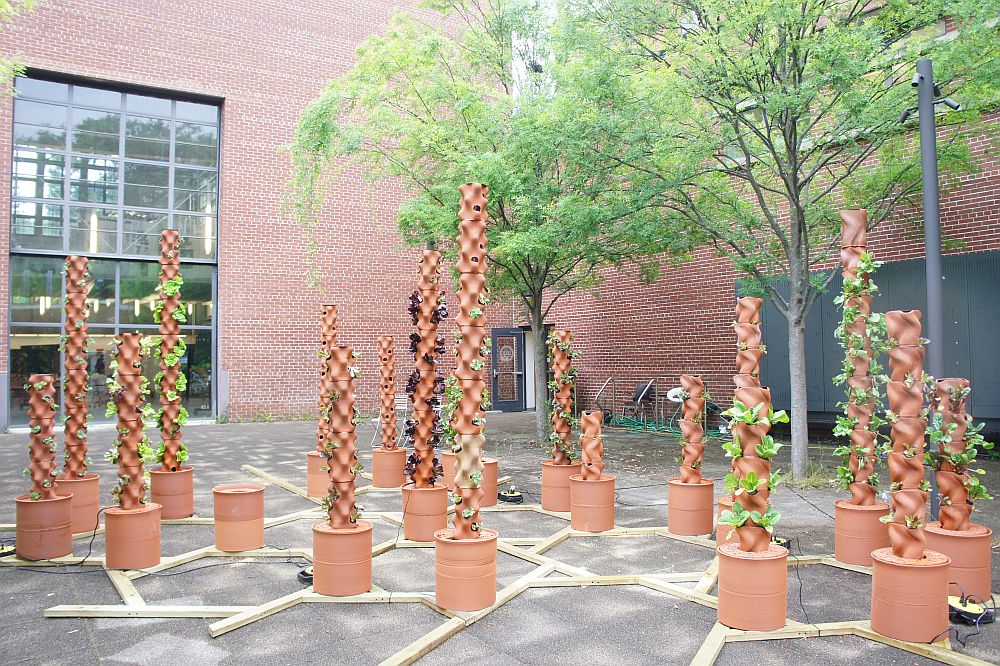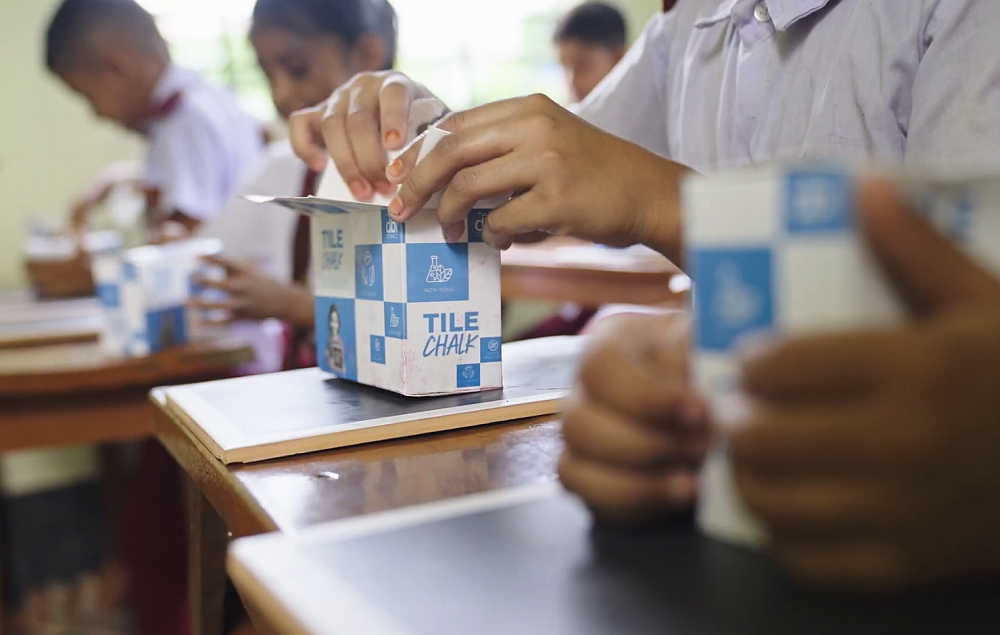
[Image above] The vertical farming ClayPonic system pictured here may help address the global challenge of food insecurity. Credit: Logman Arja
With nearly 10 billion people projected to live on the planet by 2050, 70% of whom will reside in cities, new ways of farming are essential. Traditional agriculture takes up a lot of land, but currently only about 10% of the Earth’s total land is suitable for farming. In addition, conventional outdoor farms are subject to droughts and pests, plus transporting the food to cities comes with high costs and logistical complexities.
Vertical farming is emerging as a possible solution to these challenges. This modern agricultural practice involves stacking and growing crops vertically, which offers numerous benefits:
- The vertical stacking maximizes space efficiency, required for dense urban environments.
- By growing crops locally within the city, food transportation costs are lowered, thereby making fresh produce more affordable for urban populations. Globally, 42% of the population cannot afford a healthy diet.
- Adding to the previous point, growing crops locally makes them more accessible in food deserts, i.e., areas with limited access to plentiful, affordable, or nutritious food. In the United States, food deserts affect 5 million households.
In addition to the benefits listed above, vertical farming systems reduce the risks of soil-borne diseases, pathogens, and pests because, rather than soil, nutrients are instead provided in one of two ways:
- Plant roots are suspended in the air and sprayed with a nutrient solution using atomizers (devices that emit a fine spray).
- Plant roots are suspended in a water-based nutrient solution or supported by an inert medium, such as clay pebbles, otherwise known as lightweight expanded clay aggregate (LECA).
Clay is an ideal inert medium for plant growth and development thanks to its appropriate physical, chemical, and hydraulic properties, as well as geological composition. It can slowly absorb and release water, which allows both waterlogging and drying of plants to be prevented while also reducing water circulation frequencies and over-reliance on atomizers.
Clay’s porosity also helps air pass through, which aids in the oxygenation of the plants’ root zones and the plants’ nutrient uptake compared to other materials, such as plastic. Another advantage of clay is its recyclability, reducing its environmental impact.
In contrast to the traditional clay pebbles used in hydroponics, a unique hydroponic system called ClayPonic uses 3D printing to form clay in an alternative manner that makes better use of its properties.
ClayPonic: A novel approach to vertical farming
Developed by EcoTech Lab under the leadership of Logman Arja, assistant professor of architecture at Texas Tech University, the ClayPonic system is made from ultisol clay that is processed to be inert, pH-neutral, and low density. It is then extruded layer by layer to make multilevel towers in flowing, organic shapes. The towers are geometrically designed with bumps that accommodate seedlings’ rhizosphere, i.e., the region of soil or substrate that is directly influenced by root secretions.
After fabrication, the towers are sun dried and bisque fired. A layer of glaze is then added to the outside surface, which helps reduce water loss from evaporation, while a porous structure is maintained on the inside for plant growth. Finally, the towers are anchored to a network of wooden boards during installation.
An off-site germination process “allows the seedlings to develop adequate and strong roots with sufficient length, enabling them to directly access the nutrient-rich water circulated in the tower,” writes Arja in his 2024 paper on the ClayPonic system, published in International Journal of Architectural Computing. “The topographical nature of these geometries (alternating peaks and valleys) also increases water turbulence and, therefore, improves aeration and oxygenation opportunities.”
The ClayPonic system has undergone several iterations, and the third generation integrates solar-powered atomizers to periodically deliver microdroplets of water to plant roots suspended in the air in a low-pressure and closed-loop configuration. It also incorporates a recirculating/recovery drip system, where excess water is collected in reservoirs with nutrients injected as needed.
Other potential benefits of the system:
- Uses inexpensive raw materials that are widely available and can be locally sourced, which addresses supply chain issues.
- Reduces adoption barriers because it is modular and easy to set up and customize.
- Accelerates plant growth because of both uniform nutrient concentration and pH; these characteristics also allow a variety of fruits and vegetables, from strawberries to peppers, to be grown.
- Provides both a functional and artistic element within the urban landscape.
During summer 2023, a pilot study with the ClayPonic system was conducted in the Atlanta Metropolitan Area of Georgia. Six hundred seedlings were transplanted into 100 ClayPonic modular units assembled into 20 towers. The resulting harvest of more than 160 pounds of fresh vegetables (cabbage, chard, green sorrel, arugula, lettuce, bibb lettuce, and kale) fed more than 500 homeless individuals. Up to 90% of water was saved compared to traditional soil-based methods, while reducing the cultivation cycle by 50%.
Several other pilots are now underway in Texas, California, and overseas. In an email, Arja says that commercialization is in progress: “We are wrapping up production and will be in the market in a couple of months.”
A therapeutic experience
The ClayPonic system also engages users through all five senses and helps connect communities with nature:
- Sight. Plants grow in an eye-catching vertical arrangement.
- Sound. Water trickling through the structure provides a calming effect.
- Smell. Herbs and flowers give off some wonderful scents.
- Touch. Users can enjoy the textured surfaces of the clay structures.
- Taste. Nothing is better than fresh produce for the palate.
Writes Arja, “…[users] are fully involved in a sensory experience that transcends mere food production.”
Future research will investigate different system configurations and forms, focusing on various plant types and hydroponic technologies. To realize the ClayPonic system’s full potential, streamlining fabrication and assembly processes, maximizing resource efficiency, and customizing the system to fit each application will also be required.
Concludes Arja, “By integrating additive manufacturing and ceramic fabrication, this novel innovative system not only addresses food insecurity but also reimagines the relationship between technology, nature, and human habitation.”
Learn more about the ClayPonic system here.
The paper, published in International Journal of Architectural Computing, is “Clay 3D printed hydroponics: A paradigm to address global food insecurity” (DOI: 10.1177/14780771241287826).
Author
Laurel Sheppard
CTT Categories
- Environment


